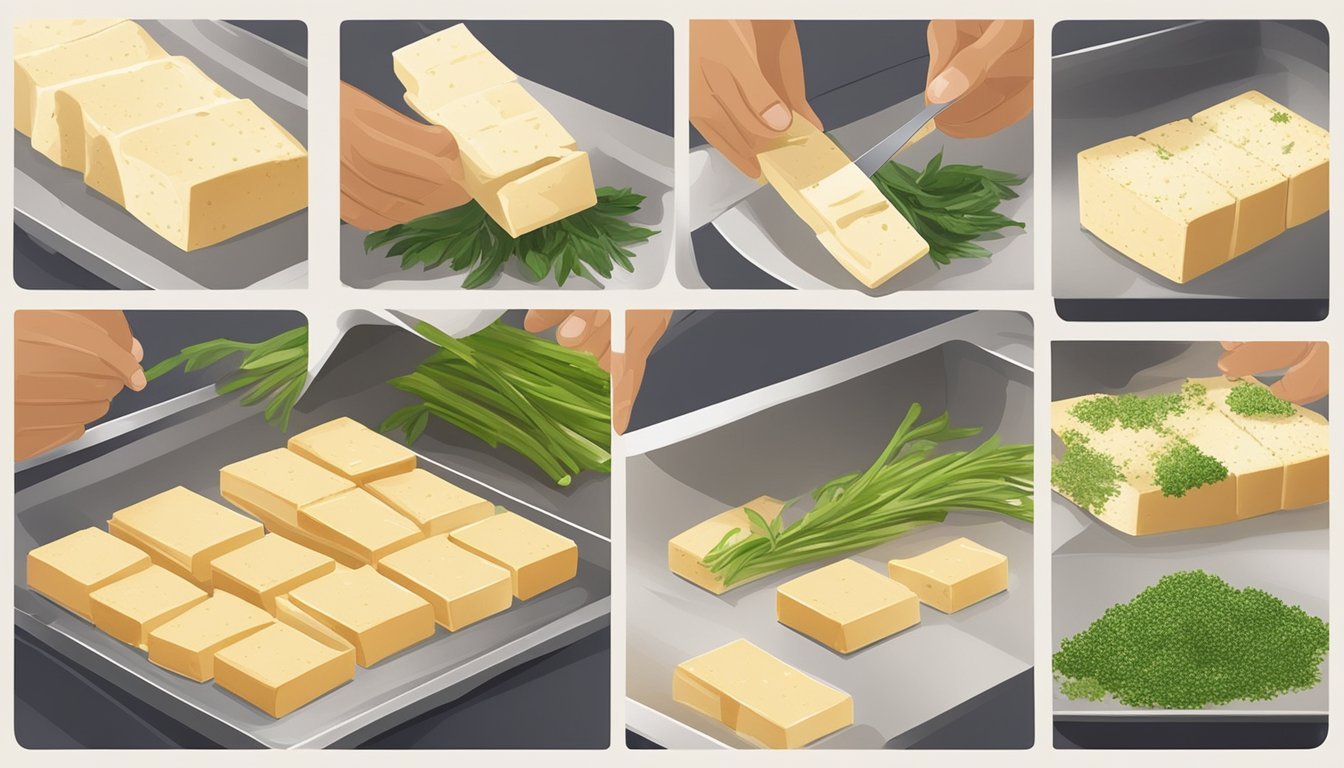How to Substitute Tofu for Cheese
A Guide to Dairy-Free Alternatives
In recent years, tofu has emerged as a popular cheese (how long does cheese last?)substitute for those looking for healthier, dairy-free alternatives. Made from condensed soy milk that is pressed into solid white blocks, tofu's versatile texture and neutral taste make it suitable for a variety of culinary applications. It is a particularly sought-after option for vegans, individuals who are lactose intolerant, and health-conscious consumers aiming to reduce their intake of animal products or saturated fats found in traditional cheeses (What wine goes well with cheese?).
Tofu's ability to absorb flavors and its varying consistencies—from silken to extra firm—allow it to easily adopt the role of different cheese types in recipes. Silken tofu, with its creamy and smooth texture, can be blended and seasoned to mimic cream cheese (how long does cream cheese last?) or ricotta. On the other hand, firmer tofu varieties can be crumbled or cubed to stand in for feta or paneer once they have been marinated or seasoned appropriately. The use of tofu as a cheese substitute not only caters to dietary restrictions but also contributes to a more sustainable and plant-based lifestyle.
While tofu provides essential amino acids and is lower in calories compared to most cheese, it is essential to enhance its flavor to successfully replace cheese in dishes. Accomplishing this involves incorporating acidic elements like lemon juice or vinegar, fats such as oils, and seasonings, including miso or herbs, to craft a comparable taste and texture profile. With these adjustments, tofu becomes not just a substitute, but a satisfying alternative in its own right for many cheese applications.
Understanding Tofu
When substituting tofu for cheese, it's important to recognize the diversity of tofu types and their nutritional values to make the most appropriate choice for your recipes.
Types of Tofu
Tofu, a plant-based protein derived from soybeans, is predominantly used in vegan diets due to its versatility and nutritional benefits. It comes in various consistencies:
Silken Tofu: This variety has a creamy texture suitable for blending into smooth mixtures resembling dairy products.
Soft Tofu: It's slightly firmer than silken but still possesses a high moisture content, which works well in recipes calling for a softer cheese texture.
Medium Tofu: With a balance between soft and firm, this type can be delicately handled and is a versatile cheese substitute.
Firm Tofu: This tofu holds its shape well and can be crumbled for feta-like consistency or sliced for cheese-like layers.
Extra-Firm Tofu: With the lowest moisture content, it is dense and can be cut into cubes or strips to mimic the texture of denser cheeses.
Nutritional Profile
Tofu is not only a shelf-stable, plant-based protein but also a source of various nutrients. An average 3.5 oz (100g) serving of tofu may contain the following:
Protein: Approximately 8 grams, making it a significant source of protein for vegan diets.
Calories: Relatively low in calories, with about 70-90 calories depending on the firmness.
Fat: Contains around 2-4 grams, with lower levels of saturated fat compared to traditional dairy cheeses.
Fiber: Minimal fiber content.
Calcium: Often fortified with calcium, contributing to the daily requirement.
Iron: Present in tofu, assisting in meeting daily iron intake.
B Vitamins: Contains B vitamins essential for various metabolic processes.
It's important to consider these nutritional factors when integrating tofu into dishes as a cheese replacement to maintain a balanced diet.
Culinary Techniques
Successful substitution of tofu for cheese relies on proper preparation and seasoning to mimic the texture and flavor of dairy-based cheeses. These techniques aim to transform tofu into a dairy-free cheese alternative that can satisfy both savory and sweet cravings.
Tofu Preparation Basics
To create tofu cheese, it's essential to start with the right type of tofu. Firm or extra-firm tofu is usually preferred for its ability to hold shape and accommodate a range of textures. Pressing tofu is a crucial step, as it removes excess moisture and creates a denser, cheese-like consistency. A tofu press can be used, or one can wrap the block in a clean kitchen towel and set a heavy object on top for at least 30 minutes.
Once drained, the tofu can be crumbled or pureed, depending on the desired final product. For a firm tofu cheese that can be sliced or cubed, baking followed by chilling helps it to firm up and develop a chewy texture. Marinating firm tofu blocks with seasonings before baking can further intensify the flavors.
Seasoning Options
Seasoning is what transforms the bland tofu into a flavorful vegan cheese. Here are some popular additions to create a variety of cheese types:
Lemon juice or vinegar: For a tangy, cheese-like flavor, add a tablespoon of lemon juice or apple cider vinegar.
Nutritional yeast: This is essential for a cheesy flavor without actual cheese; a couple of tablespoons will suffice.
Fresh herbs and spices: To add depth, incorporate finely chopped herbs like basil (how long does basil last?) and parsley, or dried spices such as garlic powder.
Savory Tofu Cheese Seasonings Sweet Tofu Cheese Seasonings Nutritional yeast A pinch of sugar Garlic (fresh or powder) Fruit preserves Basil, parsley, and thyme Vanilla extract Salt and pepper
For those seeking a savory tofu cheese, seasoning blends may include garlic powder, chopped fresh herbs, finely minced garlic, or even a sprinkling of everything bagel seasoning. To create sweet tofu cheese spreads, additions might feature a small amount of sugar, vanilla, or even fruit preserves. The key is to mix these in thoroughly to ensure an even distribution of flavor throughout the tofu cheese.
Tofu as Cheese Alternative
Tofu offers a versatile solution for those looking for dairy-free or plant-based cheese alternatives. Its variety in texture from soft to firm allows it to mimic a range of traditional cheeses, making it suitable for both soft and hard cheese substitutes.
Substituting Tofu for Soft Cheeses
Soft tofu excels as a substitute for creamy cheeses such as ricotta or cream cheese. For a convincing non-dairy ricotta, one can blend or mash soft, silken tofu with a bit of lemon juice to achieve the requisite texture and tanginess. This mixture can then be used in lasagna, stuffed shells, or as a spread.
Creating a tofu cream cheese alternative involves blending drained silken tofu with ingredients such as:
Olive oil or a neutral-tasting oil
Lemon juice or vinegar for a slight tang
Miso paste or salt for depth of flavor
To enhance the cheese-like experience, one may also incorporate nutritional yeast for its cheesy umami flavor or a dairy-free yogurt to introduce a cultured taste typically found in cheese.
Using Tofu for Hard Cheeses
Firm tofu, on the other hand, can stand in for harder cheeses. A vegan cheddar or feta alternative can be created by marinating blocks of tofu in a mixture that includes nutritional yeast, apple cider vinegar, and various seasonings which can then be used to top pizzas or salads.
For a dairy-free feta cheese, tofu should be crumbled and seasoned with lemon juice, oregano, and a pinch of salt. For those avoiding nuts, tofu provides a desirable nut-free alternative to cashew-based vegan cheeses. Although it may not melt exactly like traditional mozzarella or cheddar, it can still offer a satisfying cheese-like texture and flavor when properly seasoned.
In recipes where parmesan is used as a garnish, dried and grated tofu that's been seasoned with salt and garlic powder can serve as a low-sodium, vegan alternative. This mixture can be sprinkled over pasta dishes or salads for a finishing touch.
Nutritional Considerations:
Sodium: Tofu itself is low in sodium, but seasonings will often contain salt, so one should adjust to taste and dietary needs.
Fat Content: Tofu generally has a lower fat content compared to dairy cheeses, though adding oils can increase this, depending on the recipe.
Recipes & Applications
Substituting tofu for cheese offers a versatile plant-based alternative that can be tailored to various dishes, whether one is looking for a dairy-free cheese experience in baked goods or everyday meals. Here are specific ways to incorporate tofu as a cheese substitute in different culinary applications.
Tofu in Baked Goods
When it comes to baked goods, silken tofu serves as an excellent base for vegan cheesecakes and pies. Its texture, once blended, is creamy and smooth, mimicking the consistency of traditional cream cheese. For a classic cheesecake, blend silken tofu with a touch of sugar and apple cider vinegar, which adds the requisite tanginess. This dairy-free mixture can be poured over a gluten-free crust for those with dietary restrictions. Fruit toppings like strawberry or blueberry further enhance the dessert profile.
Everyday Tofu Cheese Dishes
Tofu can easily be incorporated into a wide array of everyday dishes, replacing cheese to create healthy and plant-based versions of familiar favorites. Here are two examples:
Tofu Paneer: An Indian classic, paneer, can be replaced with firm tofu. Marinate tofu cubes with spices, and add them to spinach for a dairy-free palak paneer.
Tofu Queso: Blend soft tofu for a creamy dip base. Spice it up with nutritional yeast, chili powder, and jalapeños for a zippy, dairy-free queso sauce.
Additionally, medium-firm tofu can be crumbled and seasoned to create a vegan ricotta that is perfect for lasagna, pasta dishes, or toast. Tofu cheese is also a great topping for pizza and can be made savory by stirring in green onions, diced herbs, or everything bagel seasoning to complement the chosen dish.
Dressing and Enhancing Tofu
In the realm of plant-based cuisine, tofu stands out as a versatile substitute for dairy-based cheeses. By employing specific techniques and ingredients, one can achieve the desired taste and texture, creating delectable vegan cheese alternatives.
Homemade Vegan Dairy-Free Cheeses
For a vegan cream cheese alternative, silken tofu is an ideal base due to its smooth texture. To replicate the tanginess of cream cheese, one can puree the tofu with a touch of apple cider vinegar or lemon juice. For a firmer cheese-like consistency, such as in vegan cheddar, one might blend soft tofu with ingredients like nutritional yeast, mustard, and miso paste, adding agar powder to help the mixture set after heating. Some well-known vegan cheese brands like Kite Hill and Daiya also mimic this approach, combining various plant-based constituents to achieve their signature flavors and textures.
Creative Flavor Twists
Expanding beyond the basics enables one to introduce creative flourishes to tofu cheese. Infusing the tofu with sweet flavors is simple; just mix in a bit of blueberry or strawberry jelly, and a pinch of sugar if needed, for an enjoyable fruity cream cheese to spread on bagels (how long do bagels last?) or toast. One can concoct a savory vegan cheese by stirring in diced fresh herbs, such as basil or chives, or even fold in a vegan cream cheese frosting enhanced with a hint of vanilla for cupcakes and desserts. Unleashing one's culinary creativity, one might whip up a unique blend using tofu as a delicious canvas for both sweet and savory applications.
Health Considerations
Choosing tofu over traditional cheese can impact one's health in several ways, including managing calorie intake and accommodating dietary restrictions like lactose intolerance.
Comparing Tofu to Traditional Cheese
Tofu, a soy-based product, is generally lower in calories and fat, specifically saturated fat, compared to most traditional cheeses. For instance, a standard serving of tofu contains about 70-90 calories and 4.5 grams of fat, with minimal saturated fat. In contrast, the same amount of cheddar cheese can have upwards of 110 calories and 9 grams of fat, with 6 grams being saturated fat. Tofu also has no cholesterol, making it a heart-healthy option.
Traditional cheeses can be high in calcium and B vitamins, nutrients essential for bone health and metabolic processes. However, they often contain more sodium, which some individuals may need to monitor. Tofu can be fortified with calcium and other nutrients, and naturally contains iron and fiber.
Nutrient Tofu (per 100g) Cheddar Cheese (per 100g) Calories 76 403 Total Fat 4.8g 33g Saturated Fat 0.7g 21g Cholesterol 0mg 105mg Sodium 7mg 621mg Calcium 350mg 721mg Iron 5.4mg 0.31mg B Vitamins Varied amounts Higher amounts
Benefits of a Vegan Diet
A vegan diet, which includes foods like tofu, is rich in plant-based proteins and is associated with a lower risk of certain health conditions, including heart disease, high blood pressure, and type 2 diabetes. It eliminates the intake of animal products, which may reduce exposure to hormones and antibiotics found in some animal-based foods. For those who are lactose intolerant, a vegan diet naturally avoids lactose, reducing digestive discomfort.
Cooking with tofu can be a way to incorporate more fiber into one's diet, an element often lacking in many Western diets. Using nutritional yeast as a cheese flavor substitute not only offers a cheesy flavor but also provides additional B vitamins. The vegan diet, while potentially lower in certain nutrients like B12, which is primarily found in animal products, can be balanced and healthy if planned correctly to include a variety of foods to meet nutritional needs.
Shopping and Storage
To successfully substitute tofu for cheese, selecting the appropriate variety and ensuring its freshness and longevity through proper storage is crucial. These considerations are vital for maintaining the texture and flavor integrity of tofu-based cheese alternatives.
Purchasing the Right Tofu
When shopping for tofu at grocery stores to use as a cheese substitute, it is important to choose the right type based on the desired consistency. For creamy cheese-like textures, silken tofu is the ideal choice due to its soft and blendable qualities. For a firmer cheese substitute, such as feta, medium or firm tofu works best, as it holds shape while providing a satisfying chew. Shoppers should also look for labels indicating the product is vegan and dairy-free to ensure it aligns with those dietary preferences.
Texture Types:
Silken tofu: cheese spreads, creamy desserts, (What wine goes well with creamy desserts?) creamy sauces
Medium tofu: crumbled toppings, slices that don't need to melt
Firm tofu: cubed feta or paneer alternatives
Dietary Considerations:
Vegan: Contains no animal products
Dairy-free/Non-dairy: Suitable for lactose intolerance and milk allergies
Storing Tofu for Freshness
Once home, tofu should be stored properly to retain its freshness and texture. Unopened shelf-stable tofu can be kept in a cool, dry place until the expiration date. Once opened, tofu requires refrigeration in a tightly sealed container. The water should be changed daily to maintain freshness. For longer storage, chilling the tofu is essential to prevent spoilage. If a firmer texture is desired, tofu can be pressed and then stored to firm up, improving its cheese-like qualities.
Refrigeration:
Shelf-stable (before opening): Store in a cool, dry place
Chilled (after opening): Keep in an airtight container, change water daily
Freezing:
Freezing tofu can alter its texture, making it chewier which may be desirable for some cheese substitutes.






